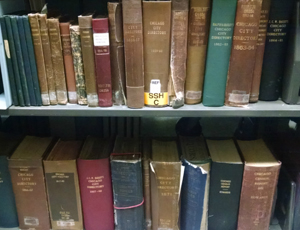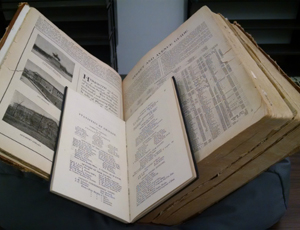We're in the dog days of summer, and there are only a few more hot weeks left before school starts. I have just the thing to cure your sweaty boredom! Check out CPL's collection of historical city directories. But wait, you say, I have more exciting things to do than to read the phone book.
Well, you'll be surprised by how fascinating these are. They can tell us so much more about the past than where people lived. For starters, looking at them arranged chronologically on the shelf gives a great visual of the rapid population boom Chicago experienced in its early years.
Not convinced? Let's take the 1844 City Directory. Chicago was a mere 7 years old. In addition to listing the inhabitants and businesses of the young city, the slim volume includes a 15-page historical sketch and 12 pages of Chicago statistics. The stats range from the members of the Common Council (City Council) to results of a city census taken in 1843, to export and import tallies for the Port of Chicago, to information about a number of religious societies. That's a lot of context you don't get when you Google a business' phone number today.
A typical entry reads, "Casey, John, milkman, res[idence] Market st. b[etween] Randolph and Wash[ington] sts." Most buildings didn't have street numbers at the time, but the size of the city was so small that they weren't necessary. Very few women are listed, though according to the census data included in the book, 3,212 of them lived in Chicago then. I found one: "Shaddle, Miss Ellen, teacher, one door South 1st Pres. Church." How's that for an address?
Let's skip ahead 67 years to 1911. Chicago had grown immensely, and so, of course, had the directory. Street numbers had been instituted, and, in fact, the street numbering system had recently been overhauled. So, this edition includes a comprehensive Street and Avenue Guide that lists the new street numbers alongside the old. This provides one great resource for tracking down a building's location when you have a pre-1911 address. (This blog post has additional resources for researching Chicago's streets.)
The full run of city directories and their successor phone books is on microfilm on the 3rd floor of Harold Washington Library Center. Hard copies are also available, with the more historical resources found either in the 5th floor's Municipal Reference Collection or the 9th floor's Special Collections.
A good, related resource to know about is Haines Chicago City Criss-cross Directory. City directories and phone books are organized by last name of the occupant, but the Criss-cross Directory is arranged by street number instead.
Want to learn more? These blog posts detail the history of phones in Chicago.




Add a comment to: Historical Chicago Directories: More Exciting Than Reading the Phone Book